Peugeot Partner Tepee 2017 User Guide
Manufacturer: PEUGEOT, Model Year: 2017, Model line: Partner Tepee, Model: Peugeot Partner Tepee 2017Pages: 292, PDF Size: 10.49 MB
Page 11 of 292
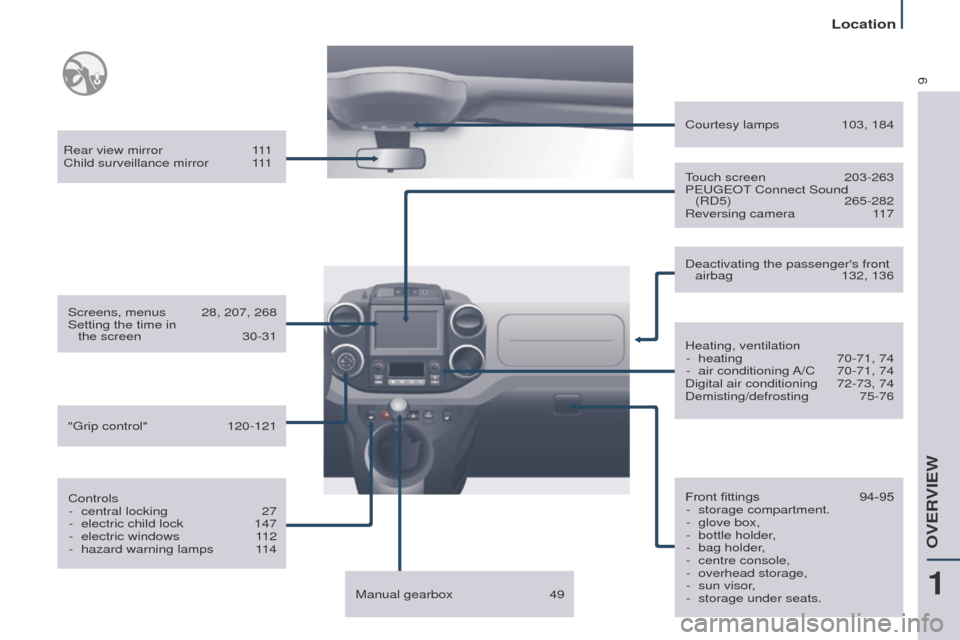
9
Partner2VP_en_Chap01_vue-ensemble_ed02-2016
Rear view mirror 111
Child surveillance mirror 1 11
Screens, menus
28, 207, 268
Setting the time in
the screen
30-31
Controls -
central locking
27
-
electric child lock
147
-
electric windows
1
12
-
hazard warning lamps
1
14 Heating, ventilation
-
heating
70-71, 74
-
air conditioning
A/C
70-71, 74
Digital air conditioning
72-73, 74
Demisting/defrosting
75-76
Courtesy lamps
103, 184
Front fittings
94-95
-
storage compartment.
-
glove box,
-
bottle holder
,
-
bag holder
,
-
centre console,
-
overhead storage,
-
sun visor
,
-
storage under seats.
T
ouch screen
203-263
PEUGEOT
Connect Sound
(RD5)
265-282
Reversing camera
1
17
Deactivating the passenger's front airbag
132, 136
Manual gearbox
49
"Grip control"
120-121
1
OVERVIEW
Location
Page 12 of 292
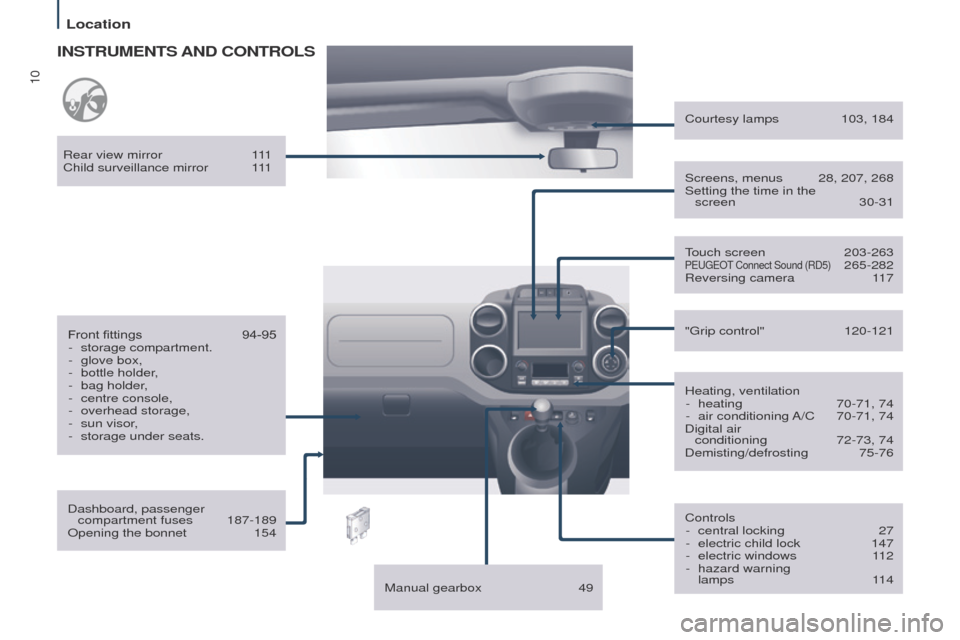
10
Partner2VP_en_Chap01_vue-ensemble_ed02-2016
INSTRUMENTS AND CONTROLS
Dashboard, passenger compartment fuses 187-189
Opening the bonnet
154
Front fittings
94-95
-
storage compartment.
-
glove box,
-
bottle holder
,
-
bag holder
,
-
centre console,
-
overhead storage,
-
sun visor
,
-
storage under seats.
Rear view mirror
1
11
Child surveillance mirror
1
11
Manual gearbox
49T
ouch screen
203-263PEUGEOT Connect Sound (RD5) 265-282
Reversing camera
1 17
Controls -
central locking
27
-
electric child lock
147
-
electric windows
1
12
-
hazard warning
lamps
114
"Grip control"
120-121
Heating, ventilation -
heating
70-71, 74
-
air conditioning
A/C
70-71, 74
Digital air
conditioning
72-73, 74
Demisting/defrosting
75-76
Courtesy lamps
103, 184
Screens, menus
28, 207, 268
Setting the time in the
screen
30-31
Location
Page 13 of 292
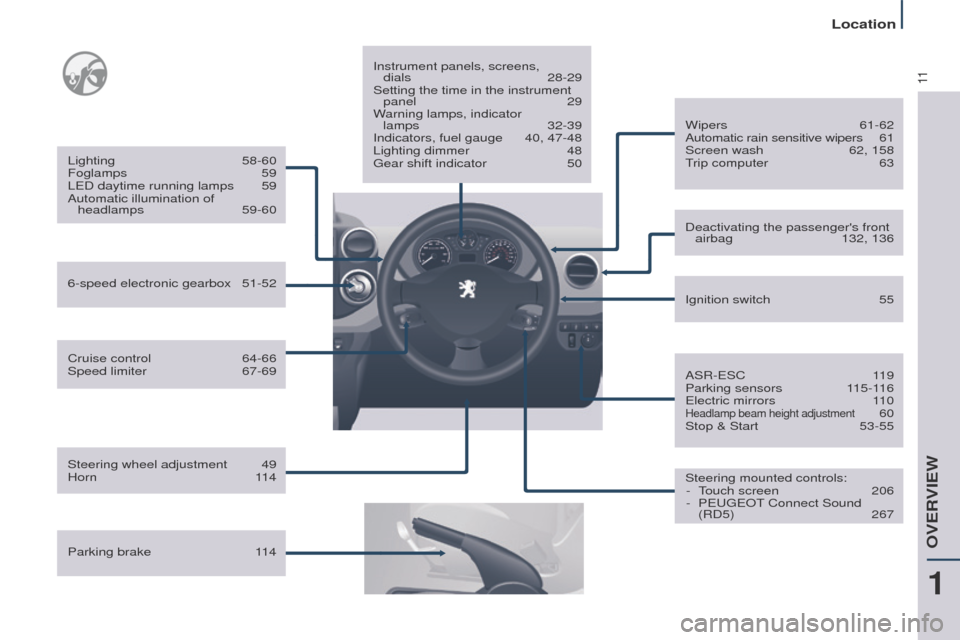
11
Partner2VP_en_Chap01_vue-ensemble_ed02-2016
Cruise control 64-66
Speed limiter 67-69
Lighting
58-60
Foglamps
59
LED daytime running lamps
59
Automatic illumination of headlamps
59-60
Parking brake
1
14Instrument panels, screens,
dials 28-29
Setting the time in the instrument panel
29
W
arning lamps, indicator
lamps
32-39
Indicators, fuel gauge
40, 47-48
Lighting dimmer
48
Gear shift indicator
50
Steering wheel adjustment
49
Horn
114 Ignition switch
55
Wipers
61-62
Automatic rain sensitive wipers
6
1
Screen wash
62, 158
T
rip computer
63
Steering mounted controls: -
T
ouch screen
206
-
PEUGEOT
Connect Sound
(RD5)
267
Deactivating the passenger's front
airbag
132, 136
ASR-ESC
1
19
Parking sensors
1
15-116
Electric mirrors
1
10
Headlamp beam height adjustment 60
Stop & Start
53-55
6-speed electronic gearbox
51-52
1
OVERVIEW
Location
Page 14 of 292
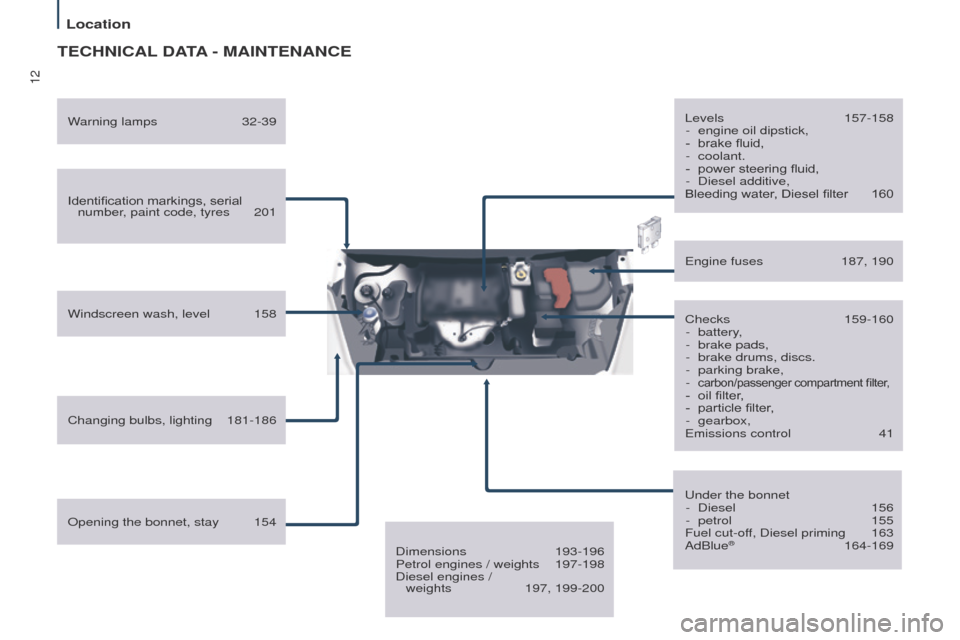
12
Partner2VP_en_Chap01_vue-ensemble_ed02-2016
TECHNICAL DATA - M AINTENANCE
Identification markings, serial
number, paint code, tyres 201
Windscreen wash, level
158
Changing bulbs, lighting
181-186 Checks
159-160
-
battery
,
-
brake pads,
-
brake drums, discs.
-
parking brake,
-
carbon/passenger compartment filter,- oil filter,
- particle filter ,
-
gearbox,
Emissions control
41
Engine fuses
187, 190
Opening the bonnet, stay
154 Levels
157-158
-
engine oil dipstick,
-
brake fluid,
-
coolant.
-
power steering fluid,
-
Diesel additive,
Bleeding water
, Diesel filter
160
W
arning lamps
32-39
Under the bonnet-
Diesel
156
-
petrol
155
Fuel cut-of
f, Diesel priming
163
AdBlue® 164-169
Dimensions
193-196
Petrol engines / weights
197-198
Diesel engines /
weights
197, 199-200
Location
Page 15 of 292
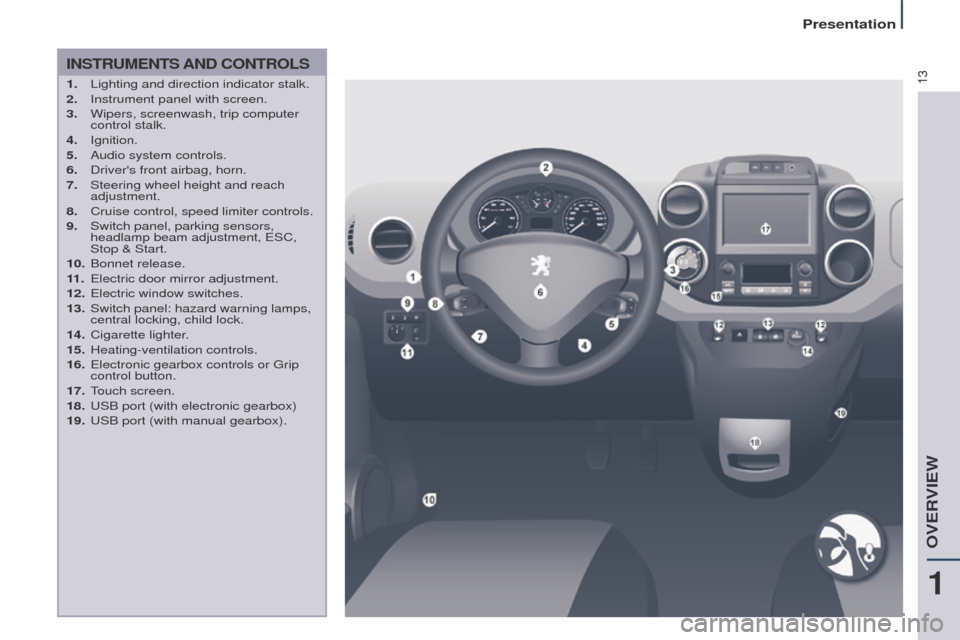
13
Partner2VP_en_Chap01_vue-ensemble_ed02-2016
INSTRUMENTS AND CONTROLS
1. Lighting and direction indicator stalk.
2. Instrument panel with screen.
3.
Wipers, screenwash, trip computer
control stalk.
4.
Ignition.
5.
Audio system controls.
6.
Driver's front airbag, horn.
7.
Steering wheel height and reach
adjustment.
8.
Cruise control, speed limiter controls.
9.
Switch panel, parking sensors,
headlamp beam adjustment, ESC,
Stop & Start.
10.
Bonnet release.
11
.
Electric door mirror adjustment.
12.
Electric window switches.
13.
Switch panel: hazard warning lamps,
central locking, child lock.
14.
Cigarette lighter
.
15.
Heating-ventilation controls.
16.
Electronic gearbox controls or Grip
control button.
17.
T
ouch screen.
18.
USB port (with electronic gearbox)
19.
USB port (with manual gearbox).
1
OVERVIEW
Presentation
Page 16 of 292
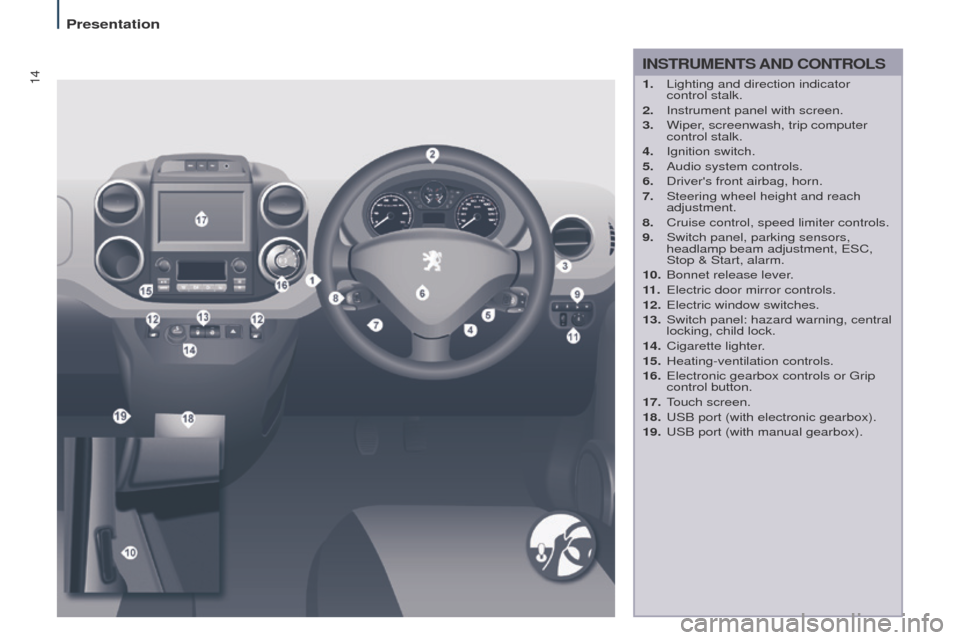
14
Partner2VP_en_Chap01_vue-ensemble_ed02-2016
INSTRUMENTS AND CONTROLS
1. Lighting and direction indicator
control stalk.
2.
Instrument panel with screen.
3.
Wiper
, screenwash, trip computer
control stalk.
4.
Ignition switch.
5.
Audio system controls.
6.
Driver's front airbag, horn.
7.
Steering wheel height and reach
adjustment.
8.
Cruise control, speed limiter controls.
9.
Switch panel, parking sensors,
headlamp beam adjustment, ESC,
Stop & Start, alarm.
10.
Bonnet release lever
.
11 .
Electric door mirror controls.
12.
Electric window switches.
13.
Switch panel: hazard warning, central
locking, child lock.
14.
Cigarette lighter
.
15.
Heating-ventilation controls.
16.
Electronic gearbox controls or Grip
control button.
17.
T
ouch screen.
18.
USB port (with electronic gearbox).
19.
USB port (with manual gearbox).
Presentation
Page 17 of 292

15
Partner2VP_en_Chap02_eco-conduite_ed02-2016
Environment
With you, PEUGEOT acts to protect
the environment.
We invite you to visit the
www.peugeot.co.uk website.As the driver, you also can contribute
to protecting the environment in the
following way:
-
drive smoothly
, without frequent
and harsh acceleration,
-
observe the service intervals;
we recommend that services are
carried out by a PEUGEOT
dealer,
authorised to collect used batteries
and fluids,
-
in order to preserve the reliability
of the engine and emission control
systems, do not use engine oil
additives. Refer to information on eco-driving
at the end of this section.
2
ECO-DRIVING
Motoring & the Environment
Page 18 of 292
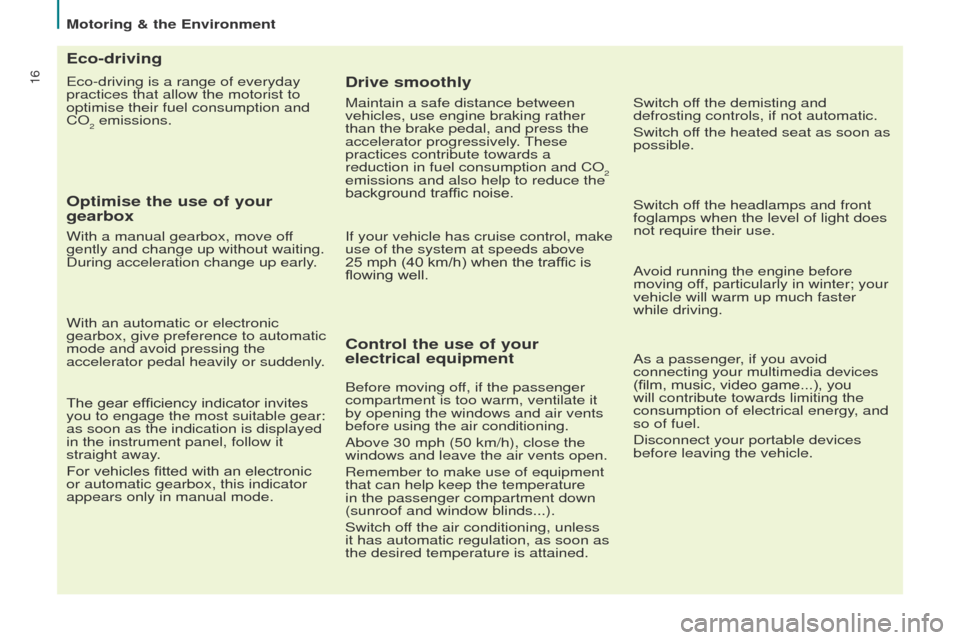
16
Partner2VP_en_Chap02_eco-conduite_ed02-2016
Eco-driving is a range of everyday
practices that allow the motorist to
optimise their fuel consumption and
CO
2 emissions.
Eco-driving
Optimise the use of your
gearbox
With a manual gearbox, move off
gently and change up without waiting.
During acceleration change up early.
With an automatic or electronic
gearbox, give preference to automatic
mode and avoid pressing the
accelerator pedal heavily or suddenly.
The gear efficiency indicator invites
you to engage the most suitable gear:
as soon as the indication is displayed
in the instrument panel, follow it
straight away.
For vehicles fitted with an electronic
or automatic gearbox, this indicator
appears only in manual mode.
Drive smoothly
Maintain a safe distance between
vehicles, use engine braking rather
than the brake pedal, and press the
accelerator progressively. These
practices contribute towards a
reduction in fuel consumption and CO
2
emissions and also help to reduce the
background traffic noise.
If your vehicle has cruise control, make
use of the system at speeds above
25 mph (40 km/h) when the traffic is
flowing well.
Control the use of your
electrical equipment
Switch off the demisting and
defrosting controls, if not automatic.
Switch off the heated seat as soon as
possible.
Switch off the headlamps and front
foglamps when the level of light does
not require their use.
Avoid running the engine before
moving off, particularly in winter; your
vehicle will warm up much faster
while driving.
As a passenger, if you avoid
connecting your multimedia devices
(film, music, video game...), you
will contribute towards limiting the
consumption of electrical energy, and
so of fuel.
Disconnect your portable devices
before leaving the vehicle.
Before moving off, if the passenger
compartment is too warm, ventilate it
by opening the windows and air vents
before using the air conditioning.
Above 30 mph (50 km/h), close the
windows and leave the air vents open.
Remember to make use of equipment
that can help keep the temperature
in the passenger compartment down
(sunroof and window blinds...).
Switch off the air conditioning, unless
it has automatic regulation, as soon as
the desired temperature is attained.
Motoring & the Environment
Page 19 of 292
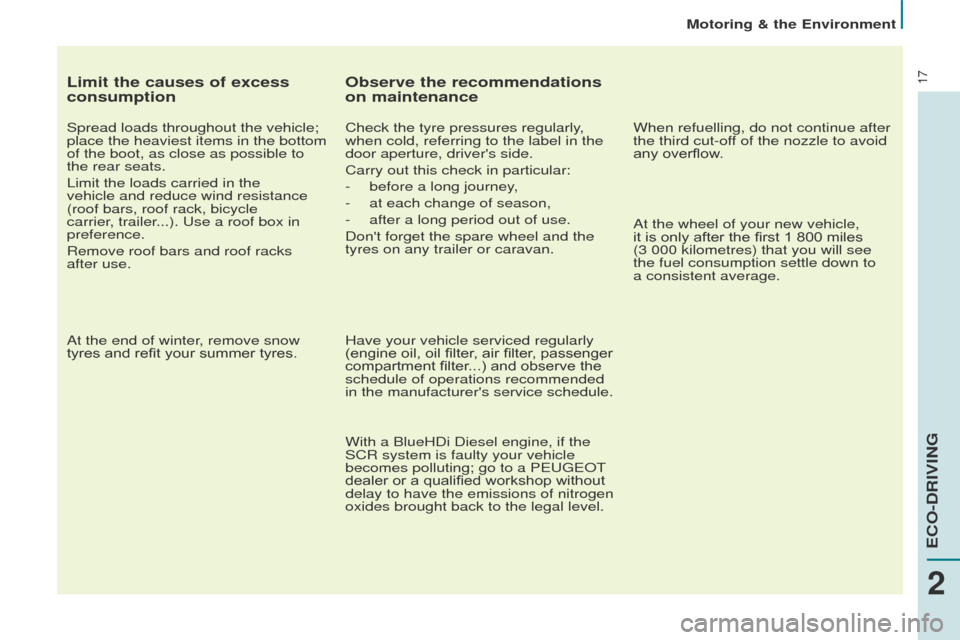
17
Partner2VP_en_Chap02_eco-conduite_ed02-2016
Limit the causes of excess
consumption
Spread loads throughout the vehicle;
place the heaviest items in the bottom
of the boot, as close as possible to
the rear seats.
Limit the loads carried in the
vehicle and reduce wind resistance
(roof bars, roof rack, bicycle
carrier, trailer...). Use a roof box in
preference.
Remove roof bars and roof racks
after use.
At the end of winter, remove snow
tyres and refit your summer tyres.
Observe the recommendations
on maintenance
Check the tyre pressures regularly,
when cold, referring to the label in the
door aperture, driver's side.
Carry out this check in particular:
-
before a long journey
,
-
at each change of season,
-
after a long period out of use.
Don't forget the spare wheel and the
tyres on any trailer or caravan.
Have your vehicle serviced regularly
(engine oil, oil filter
, air filter, passenger
compartment filter...) and observe the
schedule of operations recommended
in the manufacturer's service schedule.
With a BlueHDi Diesel engine, if the
SCR system is faulty your vehicle
becomes polluting; go to a PEUGEOT
dealer or a qualified workshop without
delay to have the emissions of nitrogen
oxides brought back to the legal level. When refuelling, do not continue after
the third cut-off of the nozzle to avoid
any overflow.
At the wheel of your new vehicle,
it is only after the first 1 800 miles
(3 000 kilometres) that you will see
the fuel consumption settle down to
a consistent average.
2
ECO-DRIVING
Motoring & the Environment
Page 20 of 292
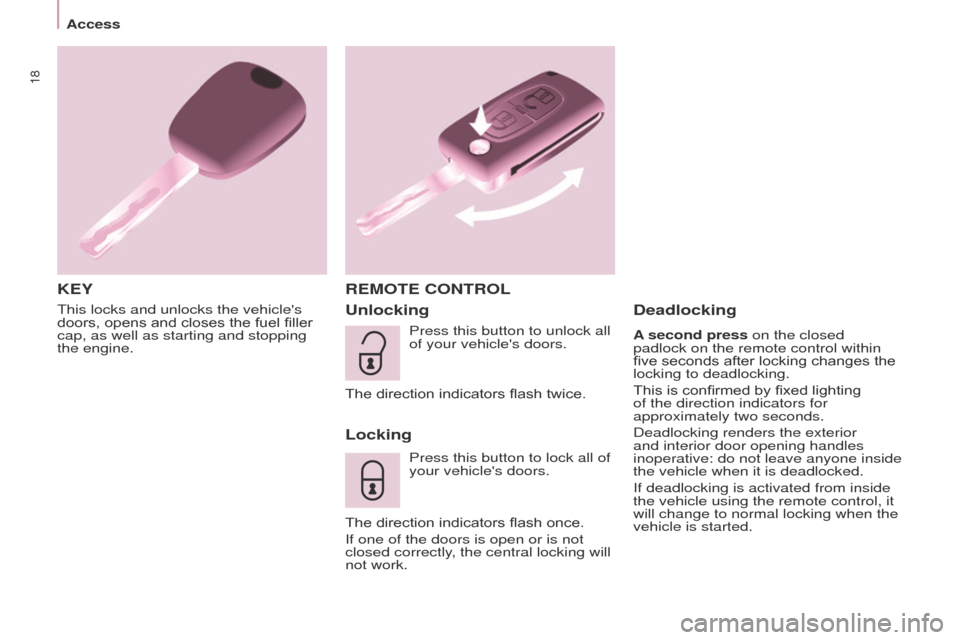
18
Partner2VP_en_Chap03_Pret-a-partir_ed02-2016
This locks and unlocks the vehicle's
doors, opens and closes the fuel filler
cap, as well as starting and stopping
the engine.
KEYREMOTE CONTROL
Unlocking
Locking
Press this button to lock all of
your vehicle's doors.
The direction indicators flash once.
If one of the doors is open or is not
closed correctly, the central locking will
not work.
Deadlocking
A second press on the closed
padlock on the remote control within
five seconds after locking changes the
locking to deadlocking.
This is confirmed by fixed lighting
of the direction indicators for
approximately two seconds.
Deadlocking renders the exterior
and interior door opening handles
inoperative: do not leave anyone inside
the vehicle when it is deadlocked.
If deadlocking is activated from inside
the vehicle using the remote control, it
will change to normal locking when the
vehicle is started.
Press this button to unlock all
of your vehicle's doors.
The direction indicators flash twice.
Access